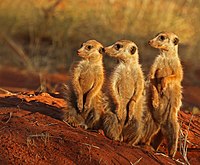
The spitting image of plant defenses: Effects of plant secondary chemistry on the efficacy of caterpillar regurgitant as an anti‐predator defense
Sign Up to like & getrecommendations! Published in 2017 at "Ecology and Evolution"
DOI: 10.1002/ece3.3174
Abstract: Abstract In the arms race between plants, herbivores, and their natural enemies, specialized herbivores may use plant defenses for their own benefit, and variation in plant traits may affect the benefits that herbivores derive from… read more here.
Keywords: plant; regurgitant; chemistry; anti predator ... See more keywords

Animal-borne video from a sea turtle reveals novel anti-predator behaviors.
Sign Up to like & getrecommendations! Published in 2020 at "Ecology"
DOI: 10.1002/ecy.3251
Abstract: Predation is a primary selection pressure contributing to both the morphological and behavioral adaptations of organisms (Brodie 1983, Lima and Dill 1990). However, studying the anti-predator behaviors of aquatic taxa such as sea turtles is… read more here.
Keywords: borne video; sea; anti predator; animal borne ... See more keywords

Enhanced fast-start performance and anti-predator behaviour in a coral reef fish in response to suspended sediment exposure
Sign Up to like & getrecommendations! Published in 2018 at "Coral Reefs"
DOI: 10.1007/s00338-018-01757-6
Abstract: AbstractDeclining water quality, in particular elevated suspended sediments, poses a significant threat to coastal coral reefs. We exposed juvenile anemonefish (Amphiprion melanopus) to two suspended sediment concentrations (0 or 180 mg L−1) for 7 d and examined their… read more here.
Keywords: performance anti; exposure; suspended sediment; anti predator ... See more keywords

The serotonin transporter gene could play a role in anti-predator behaviour in a forest passerine
Sign Up to like & getrecommendations! Published in 2019 at "Journal of Ethology"
DOI: 10.1007/s10164-019-00593-7
Abstract: Elucidating associations between behavioural variation and genes may help to understand the co-existence of different behavioural phenotypes in natural populations. In birds, two main candidate genes are known to affect exploratory and risk-taking behaviour through… read more here.
Keywords: serotonin transporter; transporter gene; anti predator; predator ... See more keywords

Qualitative analysis of additional food provided predator–prey system with anti-predator behaviour in prey
Sign Up to like & getrecommendations! Published in 2019 at "Nonlinear Dynamics"
DOI: 10.1007/s11071-019-04883-0
Abstract: Predator–prey interactions are the most common phenomena in the natural population, which are widely exploited for control of economically damaging pest species in an eco-friendly manner. It is proven that the pest adopts several mechanisms… read more here.
Keywords: behaviour prey; predator; anti predator; predator behaviour ... See more keywords

Diagnosing nest predators and anti-predator response of red wattled lapwing, Vanellus indicus (Boddaert, 1783)
Sign Up to like & getrecommendations! Published in 2020 at "Acta Ecologica Sinica"
DOI: 10.1016/j.chnaes.2020.11.004
Abstract: Abstract Identification of nest predators and anti-predator behavior of Vanellus indicus (red wattled lapwings) were studied during two constitutive breeding periods (March-August) of 2018 and 2019. The study was performed along the river Ganges, Raebareli… read more here.
Keywords: nest predators; response; red wattled; predators anti ... See more keywords

Caller characteristics influence recruitment to collective anti-predator events in jackdaws
Sign Up to like & getrecommendations! Published in 2018 at "Scientific Reports"
DOI: 10.1038/s41598-018-25793-y
Abstract: Across the animal kingdom, examples abound of individuals coming together to repel external threats. When such collective actions are initiated by recruitment signals, individuals may benefit from being selective in whom they join, so the… read more here.
Keywords: colony; caller characteristics; recruitment; caller ... See more keywords

Extensive variation in the morphological anti-predator defense mechanism of Gammarus roeselii Gervais, 1835 (Crustacea:Amphipoda)
Sign Up to like & getrecommendations! Published in 2020 at "Freshwater Science"
DOI: 10.1086/707259
Abstract: Gammarus roeselii is a common European amphipod, characterized by dorsal spines that defend against fish predation. Despite significant variability in spine length and number, the extent of this variation has never been quantified. Furthermore, widespread… read more here.
Keywords: variation; gammarus roeselii; anti predator; predator defense ... See more keywords

Testing social learning of anti-predator responses in juvenile jackdaws: the importance of accounting for levels of agitation
Sign Up to like & getrecommendations! Published in 2018 at "Royal Society Open Science"
DOI: 10.1098/rsos.171571
Abstract: Social learning is often assumed to help young animals respond appropriately to potential threats in the environment. We brought wild, juvenile jackdaws briefly into captivity to test whether short exposures to conspecific vocalizations are sufficient… read more here.
Keywords: anti predator; importance accounting; predator; juvenile jackdaws ... See more keywords

Sensory environment affects Icelandic threespine stickleback's anti-predator escape behaviour
Sign Up to like & getrecommendations! Published in 2022 at "Proceedings of the Royal Society B: Biological Sciences"
DOI: 10.1098/rspb.2022.0044
Abstract: Human-induced changes in climate and habitats push populations to adapt to novel environments, including new sensory conditions, such as reduced visibility. We studied how colonizing newly formed glacial lakes with turbidity-induced low-visibility affects anti-predator behaviour… read more here.
Keywords: sensory environment; predator; anti predator; visibility ... See more keywords

Terrestrial slugs (Mollusca: Gastropoda) share common anti‐predator defence mechanisms but their expression differs among species
Sign Up to like & getrecommendations! Published in 2018 at "Journal of Zoology"
DOI: 10.1111/jzo.12635
Abstract: © 2018 The Zoological Society of London Predation is a key selective force in the evolution and maintenance of multiple traits in prey animals. Terrestrial slugs (Mollusca: Gastropoda) are an interesting group in which to… read more here.
Keywords: slugs mollusca; terrestrial slugs; defence; mollusca gastropoda ... See more keywords